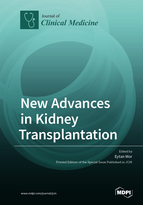New Advances in Kidney Transplantation
A special issue of Journal of Clinical Medicine (ISSN 2077-0383). This special issue belongs to the section "Nephrology & Urology".
Deadline for manuscript submissions: closed (15 December 2021) | Viewed by 24008
Special Issue Editor
2. Sackler Faculty of Medicine, Tel Aviv University, Tel Aviv, Israel
Interests: organ transplantation; immunology
Special Issues, Collections and Topics in MDPI journals
Special Issue Information
Dear Colleagues,
I would like to ask for your contribution to a Special Issue on advances in kidney transplantation. Kidney transplantation has evolved over the last 50 years to become the treatment of choice for patients with end stage renal disease. The introduction of new immunosuppressive medications in the 80s and early 90s has been associated with a significant improvement in graft survival, reaching a median survival of 15 years. However, two major hurdles have yet to be overcome; one is the development of chronic allograft nephropathy that limits graft survival and limited organ supply that makes kidney transplantation unavailable to many patients.
The following issue will focus on new advances that may answer some of these needs. First, in respect to prolonging graft survival in recent years, there has been an increased interest to improve organ quality by using machine preservation for marginal kidneys, especially those that are coming from donors after cardiac death (DCD). Another innovative development that may be shortly introduced into the clinic are biomarkers in the peripheral blood or urine specimens of transplanted patients to better predict rejection and using those to direct immunosuppressive therapy in a personalized manner. Tolerance induction has recently been a new target of clinical research with several protocols of combined kidney and bone marrow derived cells transplantation. This approach aims to lessen drug nephrotoxicity and prolong graft survival.
In the direction of expanding the number of kidneys for transplant, three topics will be discussed, including different approaches to increase the number of live donor kidney transplants by using ABO incompatible transplants, desensitization protocols, and pair exchange program. Lastly, in looking to the future, we will review current research to develop bioengineered and artificial kidneys.
Prof. Eytan Mor
Guest Editor
Manuscript Submission Information
Manuscripts should be submitted online at www.mdpi.com by registering and logging in to this website. Once you are registered, click here to go to the submission form. Manuscripts can be submitted until the deadline. All submissions that pass pre-check are peer-reviewed. Accepted papers will be published continuously in the journal (as soon as accepted) and will be listed together on the special issue website. Research articles, review articles as well as short communications are invited. For planned papers, a title and short abstract (about 100 words) can be sent to the Editorial Office for announcement on this website.
Submitted manuscripts should not have been published previously, nor be under consideration for publication elsewhere (except conference proceedings papers). All manuscripts are thoroughly refereed through a single-blind peer-review process. A guide for authors and other relevant information for submission of manuscripts is available on the Instructions for Authors page. Journal of Clinical Medicine is an international peer-reviewed open access semimonthly journal published by MDPI.
Please visit the Instructions for Authors page before submitting a manuscript. The Article Processing Charge (APC) for publication in this open access journal is 2600 CHF (Swiss Francs). Submitted papers should be well formatted and use good English. Authors may use MDPI's English editing service prior to publication or during author revisions.
Keywords
- Kidney transplantation
- Machine perfusion
- Tolerance
- Biomarkers
- Organ engineering
- Altruistic donation







